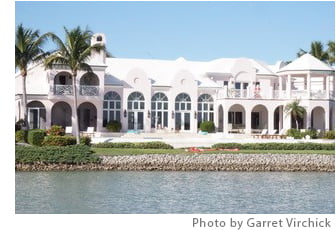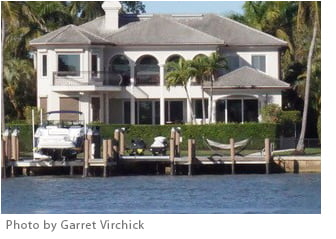
A Taste of How the 1 Percent Lives
The dramatic increase in U.S. inequality is due almost entirely to the expanding fortunes of the
1 percent. They have tripled their share of the nation’s total wealth to 21 percent since the 1970s.
Such extreme concentrations of wealth are of growing concern to economists and even one Wall Street firm. They argue that it hurts the economy for everyone.
The public’s reaction couldn’t be more different. Their preferred solution to barely coping financially is to become rich themselves. Two out of three Americans told Gallup they aspire to being rich and say that the super-wealthy are good for the country. Democrats and Republicans are equally enamored of the rich.
 What it means to be in the top 1 percent is, for most of us, an abstraction since the wealthy largely keep to their own. But the crew of the Double Sunshine tour boat are happy to show tourists the lifestyles of Florida’s rich and famous during daily tours of the dolphins and multimillion-dollar mansions on Naples Bay.
What it means to be in the top 1 percent is, for most of us, an abstraction since the wealthy largely keep to their own. But the crew of the Double Sunshine tour boat are happy to show tourists the lifestyles of Florida’s rich and famous during daily tours of the dolphins and multimillion-dollar mansions on Naples Bay.
During my Christmastime tour of the bay, the crew pointed out one property where the new owner had demolished a $49 million house to build a new one. “Tear-downs are on a tear,” says The Naples Daily News, which closely follows the real estate transactions of celebrities and chief executives.
In property after property, royal palms sway over lawns that tumble into the bay. Every house has a yacht or an empty boat slip with a full crew awaiting the owner’s return, said Greg Dyer, the tour boat company’s assistant operations director. One homeowner pays nearly $600,000 a year in property taxes. No wonder Naples has such great bike paths.
What most amazes Dyer is that many wealthy property owners “don’t actually live down here” – the houses are investments. Others inhabit their mansions only a week or two a year, he said.
Local residents include Judge Judy Sheindlin, Taco Bell’s and Best Buy’s CEOs, the billionaire owner of the Jacksonville Jaguars, bestselling author Janet Evanovich, and a few hedge fund managers.
And Naples is only the 15th-richest zip code in America, according to Bloomberg. It doesn’t hold a candle to the top-ranked Fischer Island in Miami and the high-tech enclave of Atherton, Calif., south of San Francisco.
It’s hard for most of us to imagine.
Squared Away writer Kim Blanton invites you to follow us on Twitter @SquaredAwayBC. To stay current on our blog, please join our free email list. You’ll receive just one email each week – with links to the two new posts for that week – when you sign up here. This blog is supported by the Center for Retirement Research at Boston College.
Comments are closed.








This is sheer pleasure and real taste of one’s lifestyle. It shows money can buy you everything from a dream home to a luxurious yacht. But, it is where everyone fails to understand that they buy luxury to augment their wealth, not to satisfy themselves.
I admire the 1%. I assume they’re smarter than me and have likely worked harder than me. They fully deserve their rank. But this – “They have tripled their share of the nation’s total wealth to 21 percent since the 1970s.” – is a problem, and the trajectory cannot be sustained if we want a balanced economy. I do not expect my libertarian friends to support redistribution as a solution, but I do expect them to recognize the problem.
I agree with Ken Pidcock.
In prior centuries, you could entertain in-person for a few coins per head, or make a few pots to sell, or raise and sell some grain, etc.
Now your creations might be sold to billions of people, so a few coins per head may yield astronomical amounts of money.
A possible partial remedy to the resulting inequality might be to broaden stock ownership. Securities regulation, low-cost broadly-diversified mutual funds, and IRAs/401(k)s make it possible for more to join the middle class.
Other partial remedies include investments in such infrastructure as communication, education, health, research, transportation, etc.
People thinking they will become part of the 1% or even the top 14% are steeply ignorant. That is a dream the 1% want you to think. Go ahead, admire them while your mired in general income. To really know what is what, you would have to know the full background of what they have and how that came about. Absent that, adulation of these people is dumb. Oh yes I have many investments but not that amount nor kind. The 1% are laughing up their sleeves while the dumbest think they will attain the same rank. You think you will get to the 1%? Odds are 99% against it.
Thanks for publishing this, and please do more like it. It raises lots of questions important for both pre- and post-retirees. For example, how does the mindset of “it’s-ok-to-be-rich-I-might-be-there-one-day-too” get set in the mind? Why is something so obviously false so widely believed? I’m sure your staff can think of many other issues raised by such beliefs.